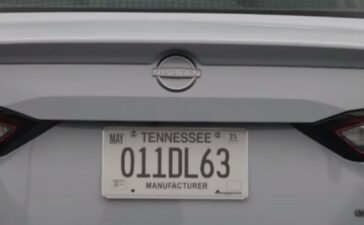Hi there, I’m Gavin J. Knox the founder of Check Engine Light. Check engine light is a tricky issue as it’s illuminated for several reasons. It can be due to a simple issue like a loose gas cap to more serious issues like catalytic converter malfunction.
A warning light is quite discomforting for drivers as they consider it as an indicator of a severe issue. I had the same experience of facing a check engine light that was only triggered by a loose gas cap. This simple issue made my whole day full of worries.
Check engine light is a crucial alert for you. It’s your car’s communication means with you. It not only indicates existing issues but also warns you about potential problems. For instance, a loose gas cap disrupts the balance of the fuel system over time.
So as soon as it is lost or wears out, the check light informs you about it. Once you solve the problem, the check light goes off. In different vehicles and under various conditions, it takes a variable amount of to for the check light to reset.
But let’s answer this question first: how long check engine light reset after a loose gas cap? The time for the check engine light to reset after correcting a loose gas cap is not measured in exact hours but typically spans across 3 to 5 driving cycles. A driving cycle involves starting the engine cold and running it until it reaches its operating temperature. This process can take a few days of normal driving. If the loose gas cap was the only issue, the light should turn off automatically as the vehicle’s onboard diagnostic system confirms the resolution of the problem.
However, if the light remains on after several days, it may suggest additional issues requiring professional diagnosis.
You might also enjoy: Why is the check engine light flashing when accelerating?
Understanding the Intricacies of the Check Engine Light
According to my long-term hands-on experience with various vehicles, I learned that the check light is something more complex than a dashboard signal.
The check light is a vital part of the vehicle’s onboard diagnostic system. It triggers when one notices an abnormal behavior or malfunction in the vehicle. It was first invented in the 1990s.
The Gas Cap’s Crucial Role in Your Vehicle’s Health
It seems awkward but you should know that gas caps play a large role in your fuel system’s functionality. It maintains the proper pressure amount of the fuel system as it doesn’t let fuel vapors leak out and air enters the system.
If the gas cap is loose or tightened improperly, the pressure of the fuel tank is lost. As a result of this, the onboard diagnostic system detects the issue and turns on the check light.
This light warns you about evaporative emission control system issues. This issue leads to poor fuel efficiency and increased harmful emissions.
Due to its small size, many drivers ignore the vital role of gas caps in a car’s overall health and performance. So from now on whenever you face this orange warning light on the dashboard, consider checking the gas cap as it’s a simple task to do. It may save you time and money before you head to a service center with the assumption of a severe problem.
Deciphering the Reset Time: A Model-Dependent Process
As a seasoned vehicle specialist, trust me that all the vehicles don’t follow a certain sample and duration of check light reset.
The check light goes off once you resolve the underlying issue. However, the time it takes I not equal in different vehicle types and models. Each vehicle has a unique routine.
The Role of Vehicle Make and Model in Reset Timelines
Each vehicle has its specific factors and parameters of the onboard diagnostic system. For example, luxury cars are equipped with more sophisticated and sensitive diagnostic systems. These systems trigger the check light as a result of the slightest error detection.
This immediate reaction is also responsive in the reset process. As they’re sensitive, the check light goes off once you resolve the problem. Conversely, it takes more time to detect the issue and reset the light in older vehicles. This sensitivity variation indicates the evolution of technological advancements in vehicles.
Understanding the Importance of Driving Cycles
The driving cycle that happens after repair has a game-changing role in the reset process. This cycle includes the cold startup and a combination of city and highway driving.
This driving cycle allows curios sensors to check different components and ensure there’s nothing wrong with the vehicle.
It takes one or more driving cycles for vehicles to reset the check light. So give your vehicle some time to ensure everything is correct and then turn off the light. The car stops warning you as soon as it realizes nothing is threatening its efficiency.
You need to be patient in this process.
It sometimes takes a few days of normal driving for the check light to turn off. If you gain knowledge about your vehicle’s communication type, you can save your money and mind piece in these conditions.
You might also enjoy: Chevy 2500 Bolt Pattern: Ultimate Guide [2023]
Navigating the Gas Cap Quirk: Tales from Different Models
I encountered many check light issues and I found out that each vehicle shows a different reaction to various issues. This fact sharpened my skills and taught me different means of communication according to vehicle models.
-
The High-End Sedan: Quick to Alert, Quick to Resolve
Once I had a client who brought a high-end European Sedan into my help center. That vehicle was known for its reliability and sophisticated engineering.
He was claiming that the check light arose after leaving the gas station. I inspected his vehicle and found out the issue was followed by an unfastened gas cap and vapor leaks. I tightened the gas cap and soon the light turned off after a half-driving cycle.
-
The Trusty Old Pickup: Slow and Steady
Another time, I had a case of an old truck that had been working for more than ten years. That vehicle wasn’t equipped with sophisticated sensors that are used in newer models.
This car’s check log was illuminated by a loose gas cap, as well. However, its reset process wasn’t as prompt as the high-end Sedan. It took more days and more driving cycles to reset the check light. So you should be more patient in dealing with older vehicles.
-
The Family SUV: A Common Scenario
I want to recall my memorable experience with a popular SUV that was famous for its efficient engineering. The owner was confused by its persistent check light. He couldn’t see any significant sign of malfunction in that car.
Ultimately it turned out that the check light was triggered due to an improperly tightened gas cap. After a few days, the light went off. This was an indicator of sensitivity and practical balance.
I recalled all these cases to emphasize the importance of knowing your vehicle’s language. Each vehicle has a different way of reflecting issues. You should understand these factors to show a suitable response to various issues.
Unraveling the Mystery: Reset Time for Check Engine Light Post Gas Cap Issue
One of my most asked questions during my journey in the automotive industry was the amount of time that vehicles need to reset the check light after resolving a gas cap issue. It’s quite surprising that this minor topic is full of mysteries for drivers and car enthusiasts.
-
The Dynamics Behind the Resetting Process
Let’s figure out the role of the gas cap before heading to its check light reset process. This small but vital component is there to maintain the pressure of the fuel tank and prevent air entrance to the fuel system.
In case of its absence or wear, the balance of the fuel system is disrupted and the onboard diagnostic system detects a fault in the fuel system and turns on the check light.
-
Experience Speaks: Real-Life Observations
Various vehicles and models are equipped with different diagnostic systems. These systems don’t have the same level of sensitivity and react differently to vehicle issues. Also, it depends on your driving habits that when your check light goes off after resolving the issue.
However, most of the vehicles need a few driving cycles and a short period to reset the check light. The driving cycle consists of a cold start and a combination of city and highway driving. I have faced both cases of a mid-2000s Sedan that restated its check light after 6 days and a newer SUV that restarted its light after a few driving cycles and only 3 days.
-
No One-Size-Fits-All Answer
The check engine light is your vehicle’s defense system to warn you about the issues. It makes you pay mechanical attention to it to avoid further damage.
On the other hand, it turns off once you fix the cause. However, if you still see this warning sign even after fixing the cause, there is a more complex issue in your vehicle that you need to address.
-
The Takeaway: Patience and Observation
You should be patient with the check light reset process. Also, it’s necessary to inspect your vehicle’s behaviors after fixing the issue.
If the light isn’t removed after a few weeks, it’s a telltale sign that you need to seek professional help and consult with a mechanic. Moreover, be attentive to regular maintenance to prevent potential car issues and ensure its smooth performance.
Briefly, the gas cap issue isn’t an unknown problem but it requires different timelines to restart the check engine light. You can enhance your driving experience by knowing this issue and being attentive to regular maintenance.
You might also enjoy: Everything You Need to Know About Mazda Check Engine Light
DIY Tactics: Resetting Your Check Engine Light
One of the most questions that I’ve been asked about in my experience, was the DIY approach of resetting the check engine light. Despite its complexity, you can deal with some check engine light issues with DIY approaches.
-
The Simple Fix: Tighten or Replace Your Gas Cap
The simplest thing you can do is to tighten your gas cap. If it’s loose, tighten it to hear the clicking sound. If you see signs of damage or wear on it, consider replacing it. If the reason for checking light illumination is vapor leaks, the light restarts after this task. But be patient because it takes a few driving cycles for the check light to go off.
-
Battery Disconnect Method: A Temporary Solution
Car enthusiasts are also interested in the battery disconnection method. It involves disconnecting the battery and reconnecting it after a few moments. This leads to the computer system restart and ultimately check engine light restart.
But keep in mind that this technique might erase your system’s useful information. So in case of using this technique, make yourself ready for your personalized settings restart and data removal.
Knowing When to Call the Pros
If you follow all the mentioned steps and still see the check light or in case your check light remains on again after a short period, it is time to seek professional help.
This check engine light can be an indicator of various issues ranging from minor to severe ones. It’s not wise to ignore it as it increases the risk of further damage.
Persistent Light: A Sign to Seek Expertise
If your restart approaches don’t work and your check light remains, there’s a deeper issue in your vehicle that needs mechanical attention. It becomes more necessary to consult with a mechanic if the check light is accompanied by other symptoms like rough idling, stalling, or unusual noises.
You might also enjoy: Catalytic Converter Check Engine Light: 8 Things You Must Know
The Role of Diagnostic Tools
Mechanics and vehicle professionals have specific diagnostic tools to read the error codes of an issue. These error codes refer to a problem that triggered the check engine light.
I appreciate these sophisticated modern tools as they help us a lot in pinpointing the exact issue.
Keep in mind that regardless of the minority of an issue, it gets worse over time if you ignore it. To tackle issues, first rely on your mechanical instinct, and if doesn’t work, ask a professional to help you with that. In this way, you ensure your vehicle’s reliability, longevity, and efficiency on the road.
Proactive Measures: Steering Clear of Gas Cap Glitches
During my long-term journey in the automotive industry, I faced a fair share of cases that which a simple issue like a loose gas cap triggered the check engine light.
This reminds us how a minor issue can become as discomforting as experiencing a warning light. Let’s delve into some preventive steps of this issue.
-
Securing the Gas Cap: A Habit to Cultivate
It’s necessary to ensure you tighten your gas cap properly after each refill. Continue screwing the gas cap until you hear the ensuring sound of a click.
This sound is a confirmation that the pressure of the fuel tank is maintained and the car won’t face fuel vapors leak.
-
Regular Gas Cap Inspections: Your First Line of Defense
Consider inspecting your gas cap for signs of wear and malfunction regularly. Gas cap degrades over time so be attentive to your vehicle’s behaviors and in case of facing reduced performance, go for replacement.
You might also enjoy: Kia Check Engine Light: 8 Causes + Fixes [2024]
Emphasizing the Role of Regular Vehicle Maintenance
Regardless of has cap, regular maintenance plays a large role in a vehicle’s overall health. It prevents potential issues before they escalate to the extent that trigger the check engine light.
Staying on Top of Maintenance Schedules
Don’t ignore your vehicle’s timely checkups. They include tasks like oil changes, filter replacements, and spark plug changes to avoid check engine light illumination.
These regular check-ups ensure there’s no issue in your vehicle and it’s functioning properly.
Wrapping Up: The Importance of Being Proactive
Finally, despite its seeming minority gas cap has a pivotal role in your vehicle’s fuel system and efficient performance. Y
ou can give yourself peace of mind by sticking to regular maintenance and timely inspecting your vehicle to ensure it’s performing smoothly.
A Call for Proactive Vehicle Care
I always recommend my clients to be attentive to prevention rather than fixing arising issues. To do that, you should be careful about your regular maintenance, try to detect any unusual noises or behaviors and address potential issues promptly. If you do so, your enjoyable safe driving experience is guaranteed.
You might also enjoy: Volkswagen Check Engine Light: 8 Causes + Fixes [2024]
FAQs
- How long does it take for an engine light to go off after tightening a gas cap?
As the vehicles are different from each other, we can’t provide you with a straightforward answer to this question. But typically it takes a few driving cycles to restart the check light. You need to wait for your diagnostic system to realize the issue is no longer present.
- Will a check engine light go off after tightening a gas cap?
The solution of tightening the gas cap usually turns off the check light. The underlying issue of that light is fuel vapors leak due to a loose gas cap. Once you remove the reason and secure the fuel system, there’s no reason for the check engine light to persist.
- How long before a check engine light goes off after a gas cap?
You should wait for a few driving cycles to reset the check light. However, different vehicles have different degrees of sensitivity so the duration may differ. Usually, newer vehicles restart the check light earlier as they have a more sensitive diagnostic system.
- How long after the loose gas cap will the check engine light come on?
The vehicle’s sensors detect this issue early. In modern cars, the check light illumination happens right after refueling within a few hours. This is due to the sensitive sensors of the onboard diagnostic system.
- Will a gas cap code clear itself?
It’s dependent on your vehicle’s ability to recheck and ensure the issue is removed. However, the self-clearing check light occurs after a few driving cycles and a few days in most vehicles.
- How do you clear a gas cap code?
First of all, you should tighten the gas cap or replace it if it’s worn out. Then wait for a few days to allow your car to detect there’s no other issue. If it takes more than two weeks, consider using an OBD2 scanner to clean the error codes manually. If still doesn’t work, consult with a mechanic to figure it out.
- How long does it take for the gas cap light to go off?
This factor depends on your vehicle’s sensitivity and your driving habits. Mostly, it should go after you resolve the issue. The vehicle needs a few days up to a week to finish some driving cycles and detect the absence of underlying issues.
I’ve seen lots of automotive issues cases in my journey and I have a recommendation for you. Try to be familiar with the check light mechanism and gas cap-related issues. This piece of knowledge empowers you to save time and money and avoid being concerned by minor issues.
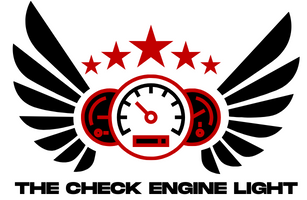

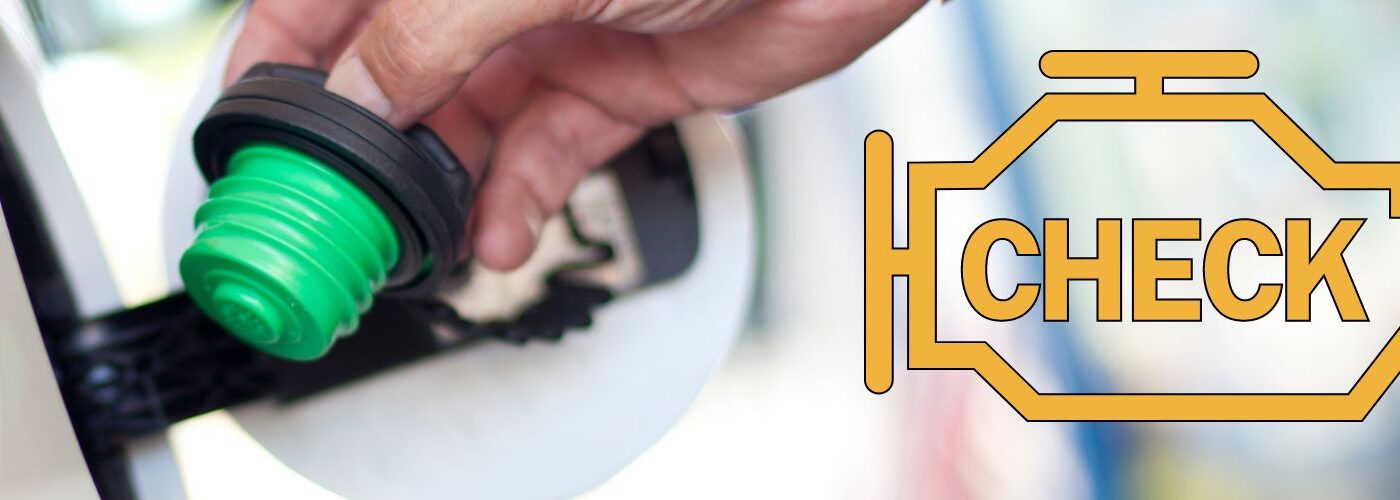
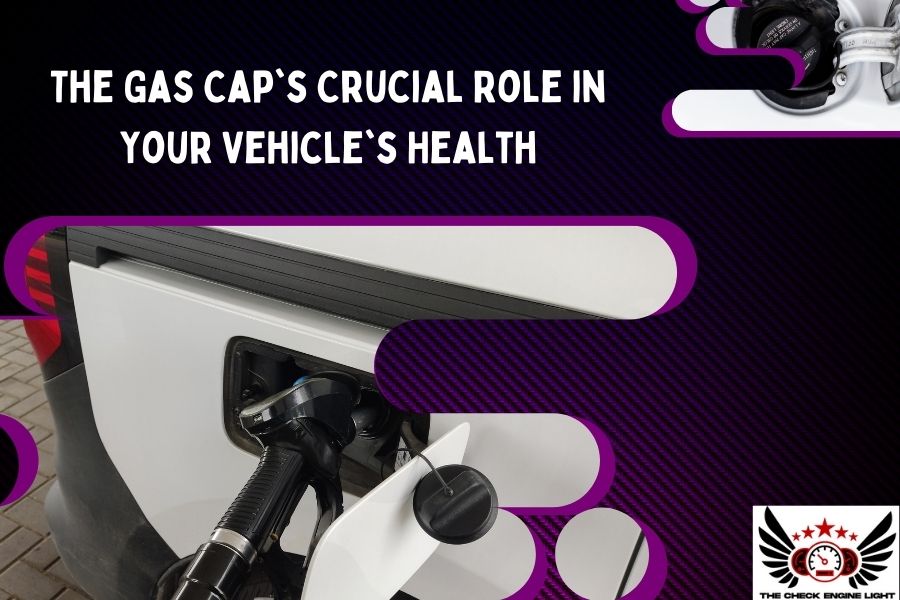
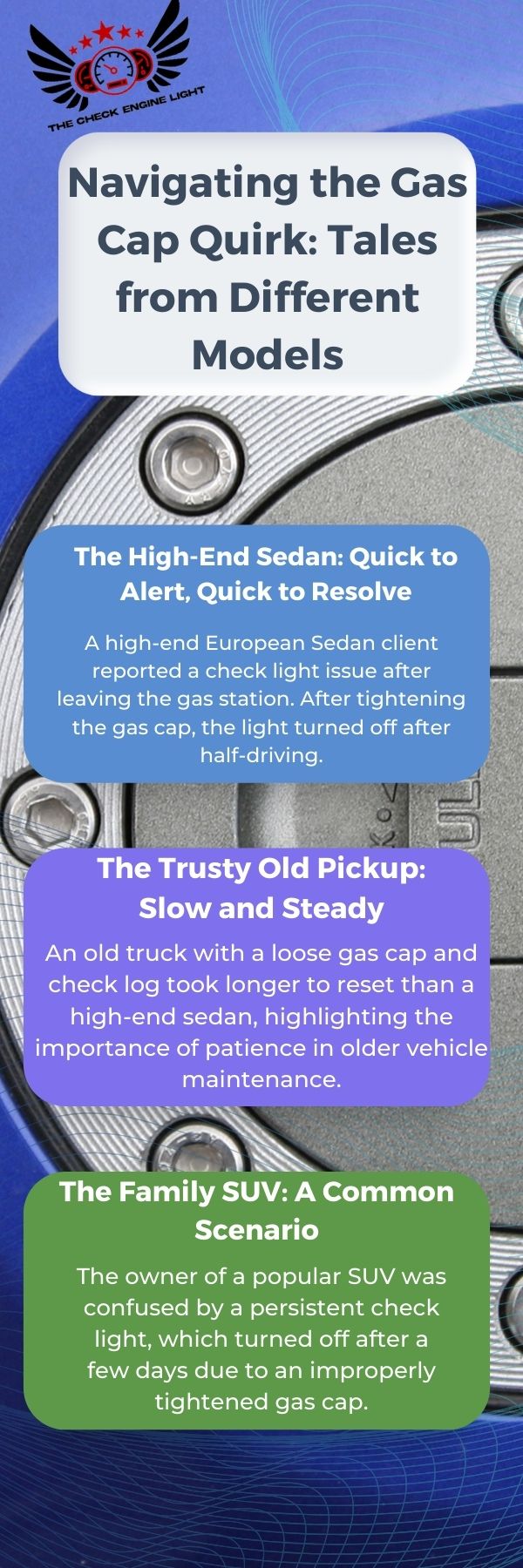
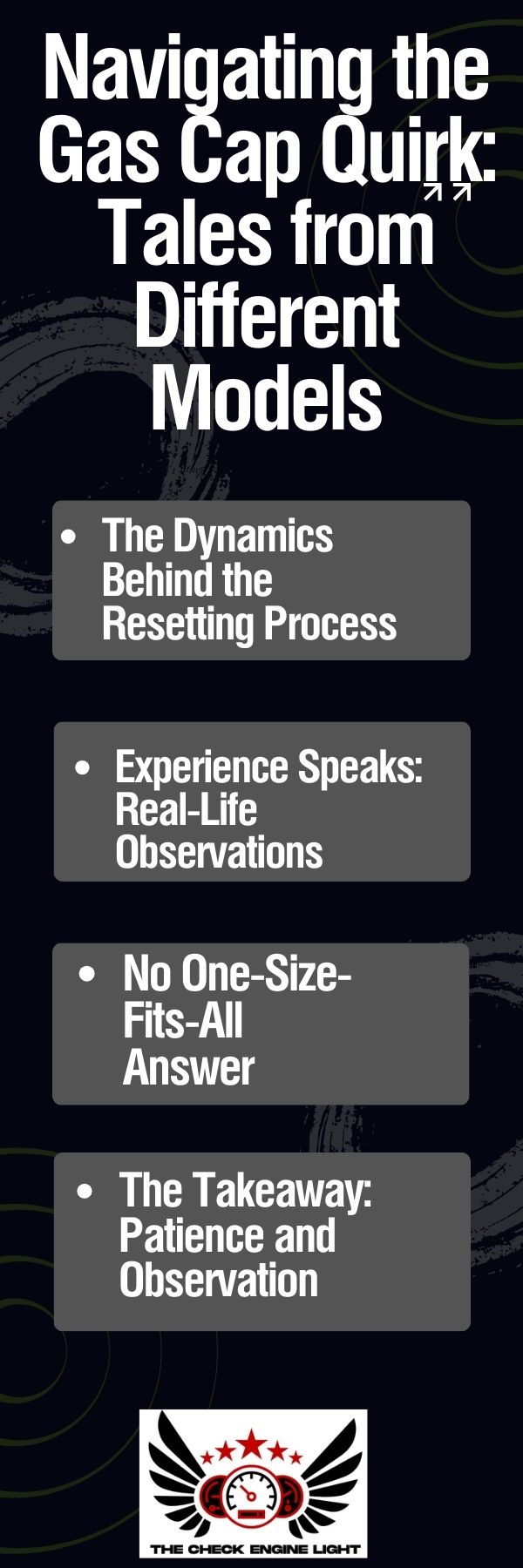
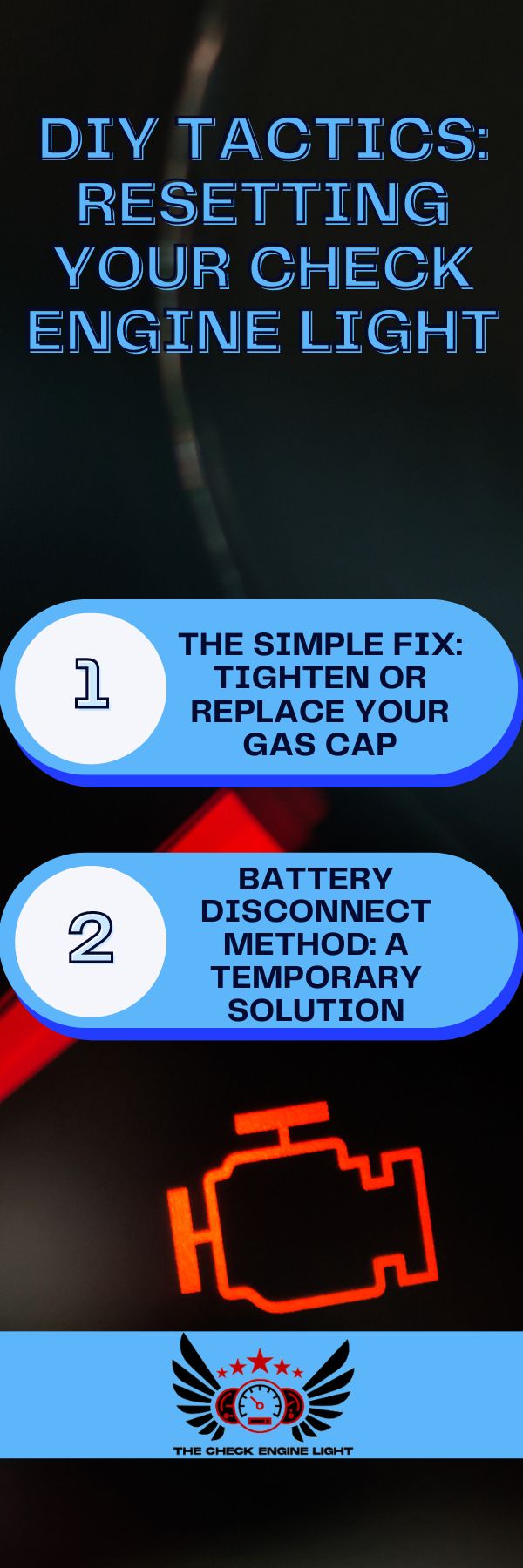
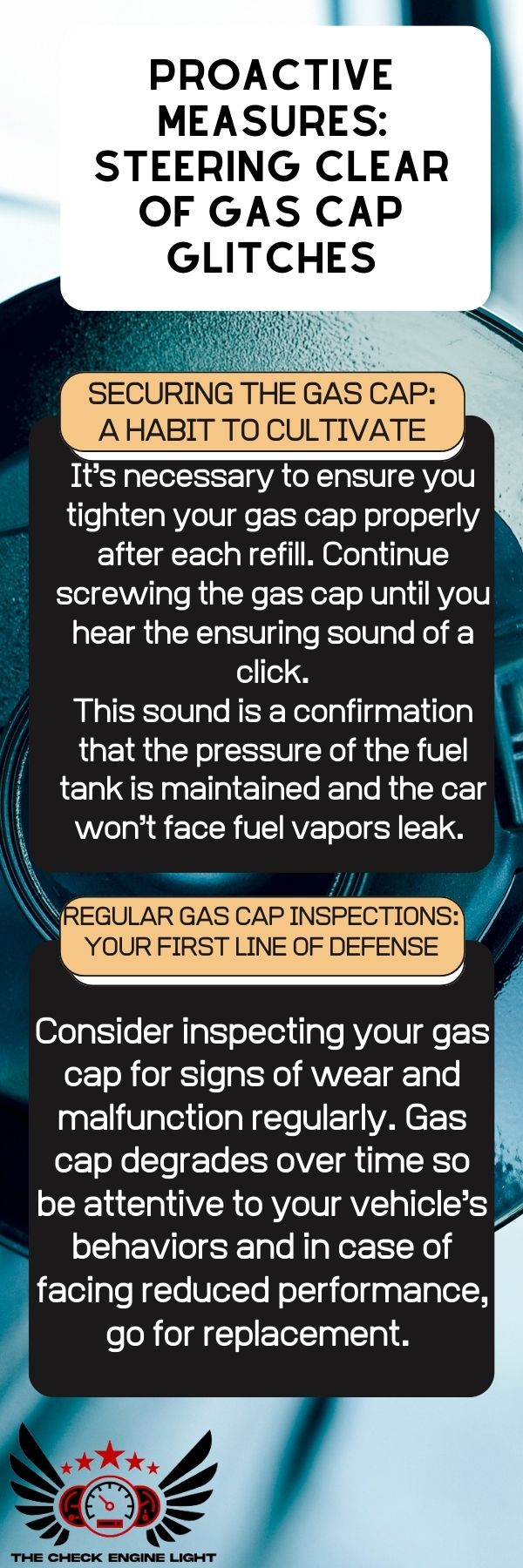
![an pic for Code p0420 Check Engine Light Fully Explained [2024]](https://thecheckenginelight.com/wp-content/uploads/2024/02/Code-p0420-Check-Engine-Light-Fully-Explained-2024-364x225.jpg)
